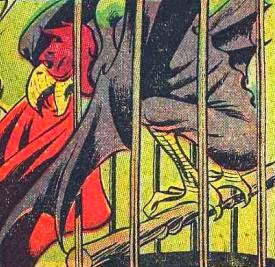 |
Salvador Dali The Persistence of Memory (detail) 1931
|
As with many games, the back of the Timeship box provides a description of what the box includes. In brief, the stated contents are a rule book (with “THREE Time Capsule Adventure Episodes”), a set of maps, a pad of character sheets, and a Timelord Screen. Dice are not mentioned, although two twenty-sided dice (numbered 0 – 9) are included. More specifically, they are “coloured spheres of many facets” says Brennan's translation of the TIMESHIP techniques. They are the “Greater Sphere of Color” and the “Lesser Sphere of White.”
According to the translation, “By our arts we have embodied in the Spheres energy sufficient for each time trip.” Voyagers (i.e., players) must “engage upon the Rolling of the Spheres” prior to traveling in time. Results of the Spheres indicate “units of the ENERGY.” Each Voyager rolls the Spheres three times, generating 3 – 300 ENERGY quanta. This is the Voyager's PERSONAL ENERGY. (PERSONAL ENERGY is generated anew prior to each time trip.) Expenditure of PERSONAL ENERGY is necessary to transport personal equipment through time, to engage in physical activity once you've reached your destination, and – according to page 7 – to “[r]eturn from a Time Capsule.” (However, there is no further mention about ENERGY costs for returning.) Additionally, if your PERSONAL ENERGY falls to zero, you die.
The PERSONAL ENERGY scores of all Voyagers in a party are added together to determine GROUP ENERGY. Although GROUP ENERGY is calculated from PERSONAL ENERGY, they form separate stores of
What happens when a party lacks sufficient ENERGY to activate a Gateway? Voyagers simply re-roll their PERSONAL ENERGY until they have enough! Duh. In fact, Brennan implies on page 21 that Voyagers can re-roll their PERSONAL ENERGY anyway. So, how much ENERGY is required to activate any given Gateway? The Timelord makes up a number. The rules speculate as to how Voyagers might prepare themselves differently when faced with a high cost Gateway as opposed to a low cost Gateway, but there are no examples from which a Timelord might learn to calculate a reasonable amount.
(I would have given each Voyager an amount of PERSONAL ENERGY equal to 100 plus the result of a percentile
The Voyagers may acquire collective equipment with any GROUP ENERGY remaining beyond the Gateway activation cost. There is an ENERGY cost for acquiring equipment Voyagers wish to have on their expedition. There may be further costs involved for actually using equipment. For instance, the Gateway ENERGY cost for a Cadillac is 50; it consumes an additional 25 ENERGY “per base unit of movement.” (Don't bother asking what a “base unit of movement” is.) Weapons have a BASIC ENERGY cost which is multiplied by the number of centuries difference between the weapons' century and the Gateway destination. Therefore, taking a bazooka to the Battle of Hastings would cost 1,350 ENERGY (each shell would cost 225).
“Voyagers may take through a Gateway, without PERSONAL ENERGY expenditure, any item of equipment they may have, physically, in the TIMESHIP.” Stated another way, whatever a player brings with him or her to the game gets a free pass through the Gateway. Otherwise, there is an ENERGY cost for equipment. A club has a cost of 3 ENERGY, a dagger has a cost of 2. A chain-mail tunic costs 40 ENERGY while a “Viking horned helmet” costs 10. Although Voyagers can wear their own clothing through a Gateway at no cost, PERSONAL ENERGY can be used to obtain “specialized clothing.” A complete outfit of period clothing suitable for the ruling class has a cost of fifty PERSONAL ENERGY; an outfit suitable for peasants costs only three. Additionally, Brennan provides a list of items that cost 2 PERSONAL ENERGY each. Among them are: a blanket, flea powder, a 5-day pack of provisions, a fire extinguisher, a pencil, and period money equivalent to one ounce of gold.
Every attack that a Voyager makes costs one point of PERSONAL ENERGY. Also, whenever a Voyager “travels a certain number of feet, one point of PERSONAL ENERGY is expended.” (I assume the Voyager is traveling under his or her own power.) Apparently, movement rates vary “from Capsule to Capsule; and will be calculated by the Timelord in advance.” Running doubles “the normal movement rate” and also doubles the PERSONAL ENERGY cost. Voyagers with a greater than average Speed Physical Ability can spend more ENERGY to go faster. On page 20, Brennan suggests that a PERSONAL ENERGY cost may be levied when Voyagers attempt other sorts of activity. Specifically, he reveals an “unwritten rule” which, as a result of being revealed, becomes a written rule.
In point of fact, when I'm running a TIMESHIP session, my unwritten rule is: 'If it's physically possible, they can do it.' Especially if they're prepared to expend PERSONAL ENERGY doing it...To assist in determining probabilities, the following 'Anything Table' is presented on the Timelord Screen.















